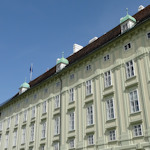
Vienna offers plenty of historical architecture to look at from the outside, but various tours let you explore what goes on behind the curtains and windows. Here’s a list of some main options…
- Book a guided tour* from numerous options
- See also:
- Sightseeing in Vienna
- Tours of Vienna
- The Vienna All-Inclusive Pass from Go City
Jump to:
History & horses
Let us begin with the more prestigious locations, rich with tales of the past (and, in one case, tails of the present).
Schönbrunn Palace
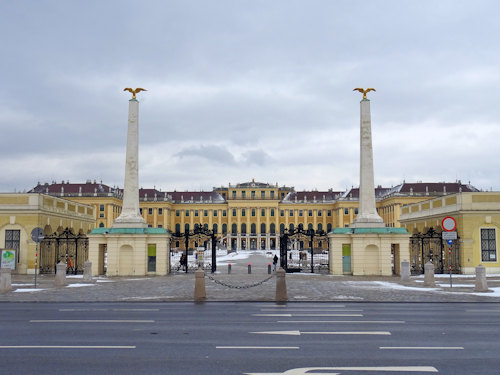
(View into the main courtyard)
Top of our list is the city’s most popular tourist destination. Schönbrunn Palace and park feature various attractions that include tours of the 18th-century palace itself.
The self-guided tours with audio guide, for example, cover up to around 40 rooms. Depending on which option you take, these include those once used by Emperor Franz Joseph and Empress Elisabeth.
The highlight on all tour options is perhaps the Great Gallery (the kind of ballroom you know from extravagant period dramas on TV).
The Hofburg
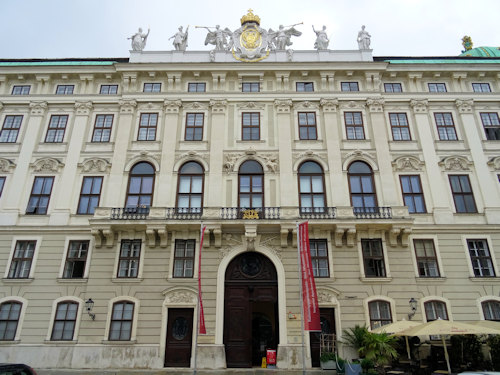
(One side of the Innere Burghof)
Centuries-old courtyards and tracts, monuments, domes, and more make up the Hofburg complex at the very centre of Vienna.
The Hofburg served as bastion, base, and home for the Habsburg imperial dynasty for hundreds of years. You can walk around the open-air areas without a ticket, and also duck into the Hofburgkapelle chapel for free.
Your main option for seeing inside is an entrance ticket (which comes with an audio guide) or guided alternative for the Sisi Museum and Hofburg. This gets you into:
- The Sisi Museum: exploring the life and character of the famous Empress Elisabeth (1837-1898) with the help of many authentic items
- The Kaiserappartements: the fully-furnished apartment rooms once occupied by Elisabeth and Emperor Franz Joseph across the late 19th century
The Spanish Riding School
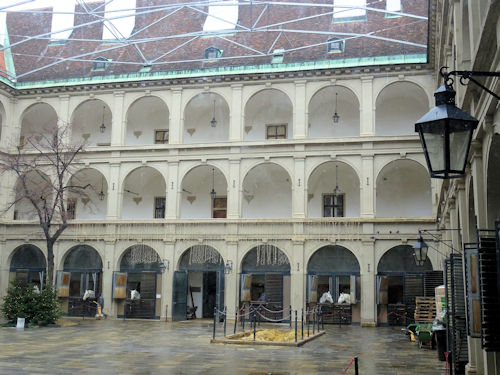
(The tours include the stables)
Tickets for a performance or a public training get you inside the 18th-century winter arena of the Spanish Riding School. But for a closer look around and a behind-the-scenes visit to the Renaissance stables (and Lipizzaner stallions), you need to join a guided tour.
The Riding School offers a near-daily general tour and a rarer architectural tour (both cover much of the same ground). The former focuses more on the stables and horses; the latter spends longer in the arena, taking you up into the roof for intriguing views over central Vienna.
Stephansdom cathedral
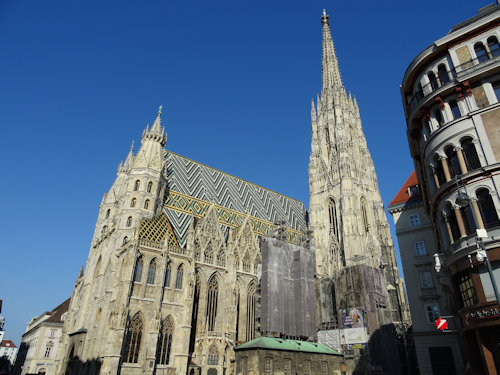
(The cathedral and south tower)
Public access to the area immediately around the entrance to Vienna’s Gothic cathedral is free. But visiting most of the nave and the towers requires tickets.
Stephansdom offers a guided tour of the catacombs that forms its own product (or is part of an all-inclusive option). They also provide free audio guides with a ticket for the main interior. And you may find special official guided tours offered seasonally: check at the cathedral.
The Albertina
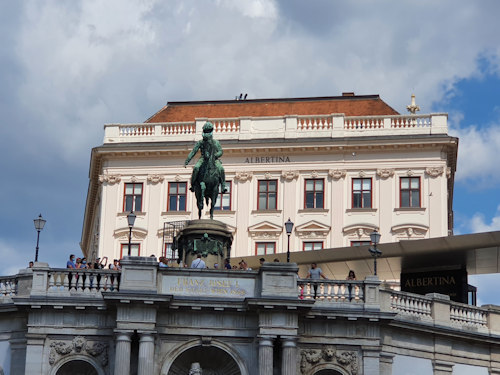
(The Albertina with the Albrecht monument in front)
Most people know this 18th-century palais as one of Europe’s more prestigious art museums.
An entrance tickets gets you into the various exhibitions within but also includes access to a self-contained section featuring twenty or so furnished 19th-century staterooms.
One of the smartphone audio guides purchasable at the Albertina is a dedicated stateroom tour.
Parliament

(Built to a Greek flavour)
The 19th century parliament building has a classical look about it on the outside. The theme continues within, with giant columned halls and statues of the ancients. And then you have the imposing historical assembly rooms for the various parliamentary houses.
Fortunately, parliament offers regular English-language tours of its interiors to offer a literal glimpse of democracy at work. And rather nicely…they’re free.
Outside Vienna
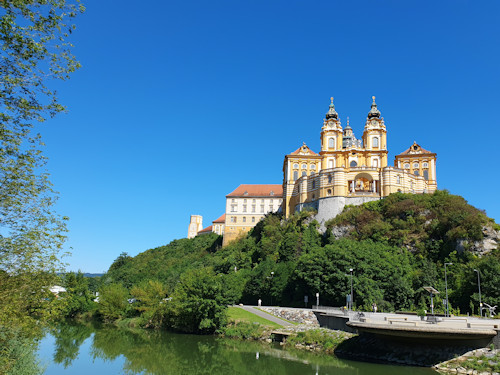
(Melk Abbey and church viewed from the river)
A short trip outside Vienna takes you to two large, historical and rather beautiful abbeys:
- Stift Klosterneuburg: almost a thousand years’ worth of history that includes a treasury, a particularly lavish Baroque Imperial wing, and a highlight of medieval art in the Verdun altar. This is so close to Vienna, it practically counts as a surburb
- Stift Melk: another one with around a millennium of history. A little further away but a grand Baroque complex atop a hill with a remarkable library. Makes a nice day trip
Museums
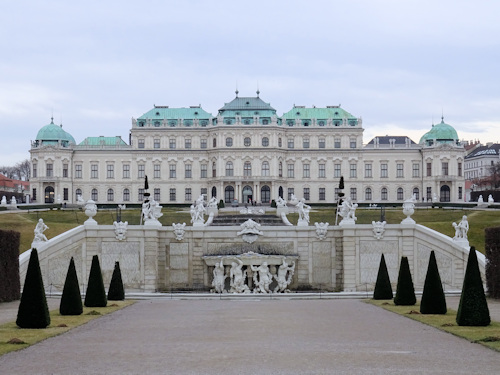
(Upper Belvedere)
Many of Vienna’s museums stand out for their interior architecture as well as their actual contents. Sometimes you don’t know if you should be looking at the ceilings or the displays.
The 19th-century Kunsthistorisches museum, for example, leaves you open-mouthed once you pass the ticket check.
And Belvedere has marble halls that make it very clear that the 18th-century owner had:
- Money
- Extroverted interior designers
- A dictionary with the words humility and modesty scratched out
Not too many museums offer specific architectural or history tours, though, with their tour focus mostly on the actual exhibitions. Some exceptions I’ve come across:
- The Naturhistorisches Museum offers English-language “cultural-historical” tours through this 19th-century jewel and up to the roof
- The MuseumsQuartier has tours that take you around this contemporary art and cultural complex, which once housed the imperial stables
Music & theatre
Of course, seeing inside Vienna’s world-leading opera and concert houses, for example, requires nothing more than a ticket to, well, an opera (not as expensive as you might think) or concert.
However, some of the leading venues also offer tours that take you places you might never otherwise see.
Musikverein
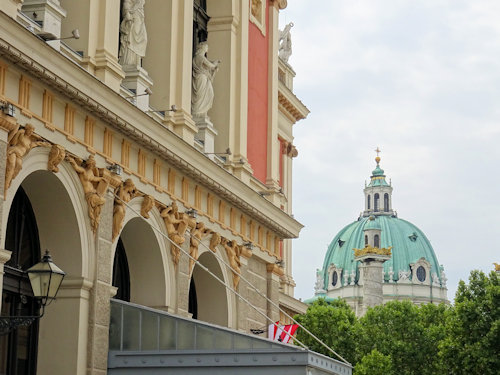
(Noted for the astonishing acoustics)
One of the great concert halls, the Musikverein opened in 1870. Folk such as Anton Bruckner, Gustav Mahler and Johann Strauss II premiered works here. The New Year’s Concert given by the Wiener Philharmoniker in the Großer Musikvereinssaal goes out live to over 90 countries.
The in-house English tours take you to, for example, a rehearsal room, the Brahms Saal and that imposing and impressive Großer Musikvereinssaal.
Konzerthaus
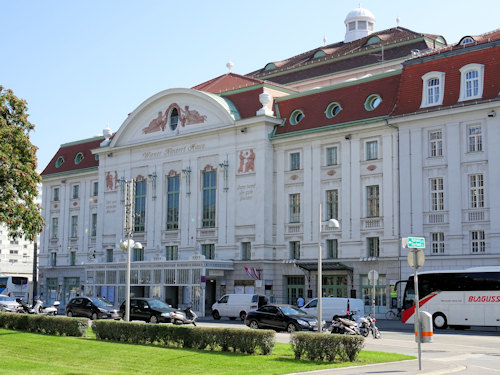
(Opened in 1913)
The Musikverein’s almost-as-prestigious colleague is the Konzerthaus. They built it too late for a Johann Strauss II premiere. But not too late for a Richard Strauss one (on the building’s first night). Or Alexander von Zemlinsky. Or Arnold Schönberg.
English tours of the building take in backstage areas as well as the four concert halls. And, with a bit of luck, you might even catch a rehearsal.
Staatsoper

(The day after the famous Opernball)
On the opera front, the 1869 Wiener Staatsoper slides confidently into the same tier as Milan’s La Scala, London’s Royal Opera House or New York’s Metropolitan Opera.
The regular in-house English guided tours offer a feast of anecdotes and a trip to places mere opera goers can never see (such as the private chamber reserved for the use of Emperor Franz Joseph).
Burgtheater

(The view from the Rathausplatz square)
Our final port of call is the 1888 Burgtheater, essentially Austria’s national theatre.
Perhaps surprisingly, the staircases form the highlight of the guided tours of the building. But then one of the artists who decorated those staircases with suitable frescoes was a young painter named Gustav Klimt.
Special events
Finally, a couple of special annual events allow us to tour places normally closed off to the public. For example:
- Open House Vienna (usually September): excellent for rarer architectural highlights, such as social housing or industrial premises.
- European Heritage Day (also usually September): notable, for example, for several private palais buildings that open up for one day of the year.
- The 2-day Easter and Christmas markets in Palais Niederösterreich: typically accompanied by tours around this historical building, including rooms dating back to the 1500s